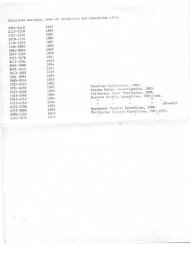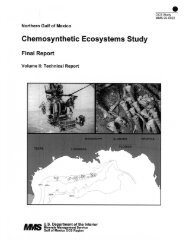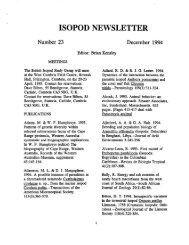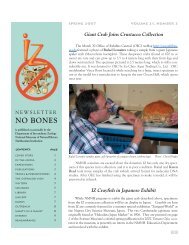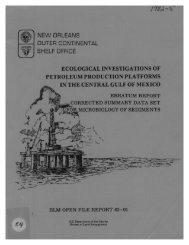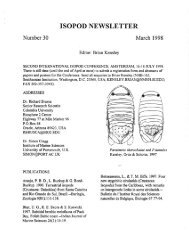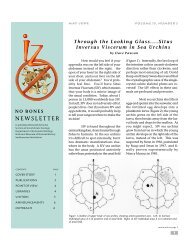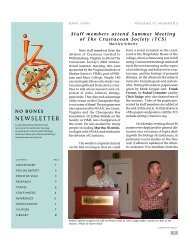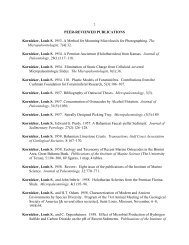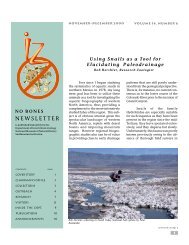Executive Summary - Department of Invertebrate Zoology
Executive Summary - Department of Invertebrate Zoology
Executive Summary - Department of Invertebrate Zoology
Create successful ePaper yourself
Turn your PDF publications into a flip-book with our unique Google optimized e-Paper software.
- A 6 station transect (L series) positioned <strong>of</strong>f Chincoteague,<br />
Virginia between 37°N and 37 .5°N south <strong>of</strong> the lease area and<br />
-- 8 stations (H, I, and J series) positioned on the continental<br />
slope or in or near submarine canyons in the central area .<br />
The 24 cluster stations in the central area were sampled<br />
quarterly to provide intensive sampling in time and space such that<br />
refined assessments <strong>of</strong> bathymetric, topographic, sedimentological, and<br />
seasonal effects could be determined . The remaining 27 stations were<br />
sampled twice yearly (during summer and winter) to provide the broad<br />
geographic coverage necessary for distinguishing bathymetric and<br />
latitudinal patterns over the region .<br />
Nine stations (C2, D1, N3, El, Fl, J1, Al, B1, I1) were chosen<br />
for collection <strong>of</strong> larger organisms by dredge and trawl (megabenthos)<br />
to be used for histopathological and chemical stulies . They were<br />
located in the central area corresponding, wherever possible, with<br />
stations samplqd for macrobenthos and sediments . These stations were<br />
sampled quarterly .<br />
The 6 water column stations (C1, D1, N3, E3, F2, J1) were located<br />
on a cross shelf transect extending from Cl <strong>of</strong>f Atlantic City, New<br />
Jersey, to J1 on the slope edge . These stations were positioned based<br />
on the known hydrographic characteristics <strong>of</strong> the area and located,<br />
where possible, in the vicinity <strong>of</strong> benthic stations . Because <strong>of</strong> the<br />
small number <strong>of</strong> stations, these sites were restricted to the central<br />
study area .<br />
The identiry oF the tracts that would be <strong>of</strong>fered for leasing<br />
under the ini :ial Middle Atlantic OCS sale (Sale 40) was no : available<br />
at the time jL' qtation selection . USGS identified three areas <strong>of</strong><br />
possible inct-,est based on geophysical data . Stations in the central<br />
study area samplEd during this initial year are shown in Figure 3<br />
along with lrazts actually leased in Sale 40 . Comparison <strong>of</strong> stations<br />
with actual leases shows coverage with regard to potential development<br />
was good, with the exception <strong>of</strong> water column studies in the<br />
northeastern and northwestern lease areas .<br />
Rationale for Location <strong>of</strong> Stations<br />
Cluster Stations . Six areas (Areas A-F) (Figure 2) were chosen<br />
as representative <strong>of</strong> bathymetric zones and/er reflective <strong>of</strong> high<br />
interest for oil and gas development . Within each orea, 4 permanent<br />
stations were fixed to cover the range <strong>of</strong> presumed biological and<br />
sedi ..entary habitats . In the 4 areas situated totally on the<br />
continental shelf (B-E), stations were chosen to at least represent<br />
ridge, flank, and swale environn.~nts <strong>of</strong> the first-order topographic<br />
system (McKinney et al . 1974) . Existing geological information<br />
indicated that sediments and sedimentary processes vari,-d considerably<br />
12



